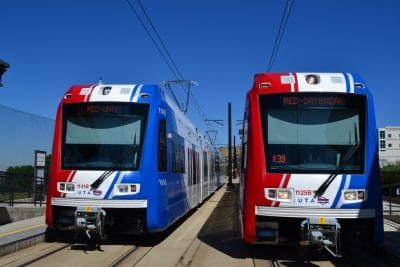Utah Train Accident Statistics
With the experience of our Utah train accident attorney, we have put together a list of several types of train accident statistics to help you better understand the potential risks that trains provide.
Table of Contents
Rail Transportation in Utah: A Brief History
 Utah has a long history with trains. In 1869, two major railroad companies united their rails in Utah territory to complete the first transcontinental railroad. Through the 1870’s and 1880’s more railroad companies emerged like the Utah Southern and Savage Bingham and Garfield. The Historic Heber Valley Railroad started running in 1899 and In 1912 the Utah Railway Company opened. Later the Union Pacific Railroad consolidated many of the existing rail companies. Utah Transit Authority (UTA) was founded in 1970 and opened the first light rail system in Utah (TRAX) in 1999. Most recently, in 2008, UTA finished a commuter rail system called the Frontrunner. UTA continues to be the primary passenger carrier service today. While trains are an important part of Utah history and provide many benefits to commuters, they also prevent some major dangers. While we will focus on relevant train accident statistics specifically for Utah, we will also compare those statistics to other major cities in the U.S. and to the nation as a whole. By sharing these statistics we hope to put the dangers of trains in perspective.
Utah has a long history with trains. In 1869, two major railroad companies united their rails in Utah territory to complete the first transcontinental railroad. Through the 1870’s and 1880’s more railroad companies emerged like the Utah Southern and Savage Bingham and Garfield. The Historic Heber Valley Railroad started running in 1899 and In 1912 the Utah Railway Company opened. Later the Union Pacific Railroad consolidated many of the existing rail companies. Utah Transit Authority (UTA) was founded in 1970 and opened the first light rail system in Utah (TRAX) in 1999. Most recently, in 2008, UTA finished a commuter rail system called the Frontrunner. UTA continues to be the primary passenger carrier service today. While trains are an important part of Utah history and provide many benefits to commuters, they also prevent some major dangers. While we will focus on relevant train accident statistics specifically for Utah, we will also compare those statistics to other major cities in the U.S. and to the nation as a whole. By sharing these statistics we hope to put the dangers of trains in perspective.
Utah Train Accident Statistics
The Federal government keeps track of three types of accidents:
- TRAIN Accidents – caused by the train itself (ex. the train derailed);
- CROSSING Accidents – caused at a railroad crossing (ex. a car or person getting hit); and
- OTHER Accidents – caused for different reasons (ex. getting on or off the train or people trespassing on railroad tracks or property).
Here are some Utah train accidents statistics from 2010-2013 based on these government records.
Percentages (2010-2013)
- Since 2010, just over HALF of the accidents in Utah were OTHER Accidents.
- CROSSING accidents and TRAIN Accidents each caused about a QUARTER of the total train accidents.
- NO TRAIN Accident caused a single death or injury in this time.
- Of all the DEATHS by train in Utah, 58% were caused at the railroad CROSSING.
- OTHER Accidents caused the other 42%.
- Of all the INJURIES by train in Utah, 85% were caused by OTHER Accidents.
- CROSSING Accidents caused the other 15%.
So, actually riding on a train is one of the safest ways of traveling with no deaths or injuries. However, you need to be especially careful getting on and off the train since statistics show that deaths and injuries occur more often this way than by riding. Never stand too close to the train when it is approaching. Always wait until it has come to a complete stop before getting on or off. The time you might save or the better spot you might get by rushing on or off the train is NOT worth the time you might lose from potential injury or death. (sour
Actual Numbers (2010-2013)
There were 224 total accidents in Utah in the last 4 years. Here is the breakdown by year:
- 2013 – 61 accidents
- 2012 – 54 accidents
- 2011 – 49 accidents
- 2010 – 60 accidents
In the last 4 years, 24 people died in train accidents. The following is a breakdown of numbers killed each year and by specific train companies:
-
-
- 2013 – 7 deaths (2 by the Frontrunner, 2 by TRAX, and 3 by Other Train Companies)
- 2012 – 5 deaths (0 by the Frontrunner, 3 by TRAX, and 2 by Other Train Companies)
- 2011 – 7 deaths (1 by the Frontrunner, 1 by TRAX, and 5 by Other Train Companies)
- 2010 – 5 deaths (2 by the Frontrunner, 3 by TRAX, and 0 by Other Train Companies)
-
128 people were injured since 2010. Here is the same formatted breakdown as above:
-
-
- 2013 – 32 injuries (4 by the Frontrunner, 3 by TRAX, and 25 by Other Train Companies)
- 2012 – 34 injuries (5 by the Frontrunner, 6 by TRAX, and 23 by Other Train Companies)
- 2011 – 25 injuries (2 by the Frontrunner, 4 by TRAX, and 19 by Other Train Companies)
- 2010 – 37 injuries (0 by the Frontrunner, 4 by TRAX, and 33 by Other Train Companies)
-
All of these numbers show consistency over time. Increases over the years probably come from the added Frontrunner and TRAX stations and routes. It may also just come from the increasing number of people using trains. As people become more accustomed to traveling on or driving near these trains, it is likely that the number of deaths and injuries will decrease. In comparison, Utah’s public trains do not cause as many deaths and injuries as other train companies outside of the state. This might be because these companies travel more miles and carry more people.
Comparison to National Statistics
Here is some recent information on deaths and injuries caused by trains in the U.S. The number of deaths in the U.S. caused by trains from 2010-2012 (no data for 2013 yet):
-
-
- 2012 – 262 deaths
- 2011 – 228 deaths
- 2010 – 221 deaths
-
This is still relatively small percentage when compared to the national population of 300 million. The increase in deaths may simply come from the increase in train usage. Despite the reason, the growing numbers remain disconcerting. Comparing Utah to the national total, Utah Train accidents cause only about 1% of all train related deaths. It is also important to understand who was hurt in these accidents. Here is the break down of who was killed by a train in the U.S. during 2012.
-
-
- 25% – Pedestrians
- 23% – Suicides
- 19% – People in a public transportation area
- 18% – People in another vehicle
- 11% – Others
- 4% – Train Passengers
-
It appears that the most dangerous spots are outside of the train. The obvious idea is that the less protection a person has the more likely they are to be killed by a train. So, please be careful any time you are near a train. The number of injuries caused by trains in the U.S.:
-
-
- 2012 – 23,165 injuries
- 2011 – 22,912 injuries
- 2010 – 25,222 injuries
-
Utah only sees about 1 of every 250 train related injuries.
Other Major Cities
Deseret News compared light-rail accidents in Salt Lake City with other major cities from 2007 to 2010. During this time period, Salt Lake tied for 3rd out of 10 major cities for the number of ACCIDENTS:
- Portland – 169
- Phoenix – 113
- Salt Lake City – 94
- Sacramento – 94
Salt Lake tied with Portland for 2nd in number of DEATHS:
- San Jose – 8
- Portland – 7
- Salt Lake – 7
It took 4th in number of INJURIES:
- Portland – 162
- Phoenix – 118
- Sacramento – 88
- Salt Lake City – 84
We understand that each of the cities listed above have different population densities and have been around for different lengths of time. However, the numbers at least give us a perspective of how safe Utah’s public transportation is.
Other Methods of Traveling
Despite the seemingly large statistics given here, riding trains are often much safer than driving personal cars.
-
-
- From 2003 to 2008, there were 1.42 deaths for every 100 million miles traveled by car.
- Compare that to a commuter train like Frontrunner at .06.
- This means that 24 times more people were killed by car than by train.
- The numbers for bus deaths was similar at .05 and .02 for other rail transportation.
-
Other Stats
Here are some other potentially relevant Utah train accident statistics to understand its potential risks. The number of people using TRAX more than tripled from about 490,000 boardings in 2000 to 1.6 million in 2011. UTA has continued to increase the number of vehicles that it uses. Here is the breakdown for every 2 years:
-
-
- 2012 – 82 light rail vehicles (TRAX) & 36 commuter rails (Frontrunner)
- 2010 – 43 light rail vehicles & 34 commuter rails
- 2008 – 46 light rail vehicles & 18 commuter rails
- 2006 – 44 light rail vehicles & 0 commuter rails
-
Train Warning signals, such as the lights and gates at crossings, are designed to go off 25-40 seconds before the train crosses. A TRAX light-rail train will cross roadways about every 20-40 minutes. This is a great deal of information. However, we hope all of these train accident statistics will help you be informed about how often and how serious these accidents can potentially be. If you or a loved one has been injured in a train accident, please feel free to call Good Guys Injury Law at (801) 506-0800 for a free consultation. We can help you deal with the complicated legal aspect so that you can focus on healing.
Photos “Red Line Trax at University Medical Center” copyright by Garrett.
Data source: safetydata.fra.dot.gov
Free Consultation
Learn your Rights. Get Answers. Free.
